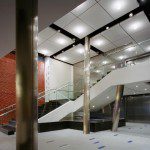20 Years of CORE Building the Cornerstones of Georgetown
By • January 17, 2014 0 2358

For the team at CORE Architecture and Design, their story of success began with Dean & Deluca.
Twenty years ago, the fledgling practice was building its business in the middle of a recession, finding most of their projects redesigning corporate interiors.
When Dean & Deluca hired the company to redesign the historic market house on M Street, a landmark piece was added not only to Georgetown’s growing pedigree, but also to CORE’s.
“That’s what really launched our retail and restaurant practices because, once it was built, we had immediate credibility,” said Dale Stewart, managing principal of CORE. “People said, ‘Well, if you can do Dean & Deluca, you can certainly do my retail.’”
That project lead to increasingly creative ventures in retail, restaurants and historic renovation and adaptation. Fast-forward to the practice’s 20th anniversary, and CORE has grown to hold one of the largest and most diverse resumes in the District.
Some of the company’s most recognizable projects include Mei n You, Ping Pong, Georgetown Cupcake and the Bank of Georgetown’s multiple locations, among others.
Located at 1010 Wisconsin, just a couple blocks away from Dean & Deluca, CORE’s office is a sleek, modern space conducive to the firm’s collaborative nature, one of the keys to its many achievements.
In the back room where all of CORE’s members can see them, idea boards are filled with pictures, fabrics and trinkets that will eventually grow to inspire the architecture and design of spaces across D.C.
“The great thing about us right now is that we have this diversity of projects and also this diversity of talent,” said Guy Martin, CORE principal. “We have people who will work on some place the like Sweetgreen for two weeks, then switch to an office building, then switch back.”
The practice consists of over 30 architects and designers. Many of those people will work on multiple projects simultaneously, and communication about projects is encouraged throughout the office.
“I think the culture of our office is very casual. We’re a very collaborative office so there’s not a lot of hierarchy,” said Allison Cooke, a senior designer at CORE. “We’re lucky to have a lot of people who are very talented but also very self motivated.”
Over the 17 years CORE has been located in Georgetown, it watched the community grow around it.
“Georgetown is still a very design-centered community. The sheer number of architects, interior designers, show rooms, furniture retail – it’s kind of marvelous,” Martin said.
“It’s definitely our home,” Stewart added.
For Martin, who joined CORE in 2007, moving to the firm was a true homecoming. He was raised here, and his father, now at the healthy age of 101, still resides in Georgetown. He remembers the replacement of biker bars with French bistros, the migration of antique dealers up and down Wisconsin, and the old storefronts of hardware and tack stores on M Street.
On many occasions, CORE aided that transformation. Sweetgreen, for instance, used to be a Hamburger Hamlet.
The projects Stewart, Martin and Cooke enjoyed most are those that tested them in their abilities and acted as catalysts for the expansion and growth of surrounding communities. Dean & Deluca was one example, along with the Atlas Performing Arts Center on H Street.
Their restaurants, retail stores and other venues draw people in, helping businesses grow their brand and communities profit.
The ultimate goal of the practice, according to Stewart and Martin, is to take on a project that will converge all of the firm’s talents in one building: a boutique hotel that they would build from the ground up.
Such a space would challenge their knowledge of the restaurant, hospitality and retail industry, it would draw on their experience building luxury apartments and hotels, and would stretch them further by combining them in ways they haven’t faced before.
The business itself, however, does not want to build up too far.
“We don’t ever want to get awfully, awfully big because I think the success of the firm rests on this collaborative effort,” Martin said. “You can’t do that with 100 people.” Stewart agreed, saying that he never wanted to grow so large that the principals couldn’t be involved in every project.
“I think that high level of quality,” Cooke added, “is something that we’ll stress overall.”
- CORE’s office suite







